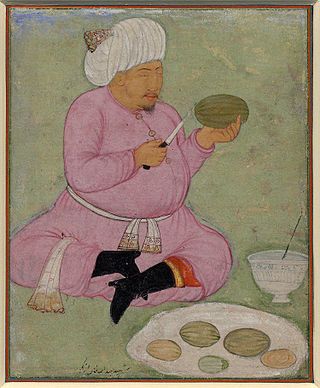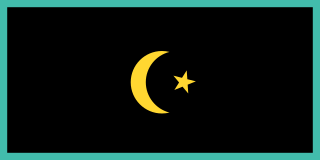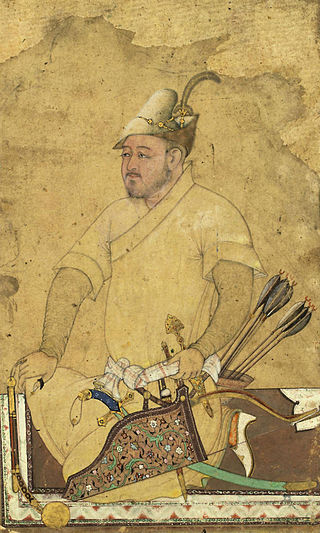
Uzbekistan is a landlocked country in Central Asia. It is itself surrounded by five landlocked countries: Kazakhstan to the north; Kyrgyzstan to the northeast; Tajikistan to the southeast; Afghanistan to the south, Turkmenistan to the south-west. Its capital and largest city is Tashkent. Uzbekistan is part of the Turkic languages world, as well as a member of the Organization of Turkic States. While the Uzbek language is the majority spoken language in Uzbekistan, Russian is widely used as an inter-ethnic tongue and in government. Islam is the majority religion in Uzbekistan, most Uzbeks being non-denominational Muslims. In ancient times it largely overlapped with the region known as Sogdia, and also with Bactria.

Khiva is a district-level city of approximately 93,000 people in Khorazm Region, Uzbekistan. According to archaeological data, the city was established around 2,500 years ago. In 1997, Khiva celebrated its 2500th anniversary. It is the former capital of Khwarezmia, the Khanate of Khiva, and the Khorezm People's Soviet Republic. Itchan Kala in Khiva was the first site in Uzbekistan to be inscribed on the World Heritage List (1991). The astronomer, historian and polymath, Al-Biruni was born in either Khiva or the nearby city of Kath.

Abdullah Khan (1533/4–1598), known as "The Old Khan", was an Uzbek ruler of the Khanate of Bukhara (1500–1785). He was the last uncontested Shaybanid Khan of Bukhara from 1583 until his death.

This article discusses the administrative-territorial division of the Republic of Uzbekistan. The Article 68 of the constitution of Uzbekistan defines:
The Republic of Uzbekistan shall consist of regions, districts, cities, towns, settlements, kishlaks and auls (villages) in Uzbekistan and the Republic of Karakalpakstan.

Urgench is a district-level city in western Uzbekistan. It is the capital of Xorazm Region. The estimated population of Urgench in 2021 was 145,000, an increase from 139,100 in 1999. It lies on the Amu Darya River and the Shavat canal. The city is situated 450 km (280 mi) west of Bukhara across the Kyzylkum Desert.

The Khanate of Khiva was a Central Asian polity that existed in the historical region of Khwarazm from 1511 to 1920, except for a period of Afsharid occupation by Nader Shah between 1740 and 1746. Centred in the irrigated plains of the lower Amu Darya, south of the Aral Sea, with the capital in the city of Khiva. It covered present-day western Uzbekistan, southwestern Kazakhstan and much of Turkmenistan before the Russian conquest at the second half of the 19th century.

The Emirate of Bukhara was a Muslim polity in Central Asia that existed from 1785 to 1920 in what is now Uzbekistan, Tajikistan, Turkmenistan and Kazakhstan. It occupied the land between the Amu Darya and Syr Darya rivers, known formerly as Transoxiana. Its core territory was the fertile land along the lower Zarafshon river, and its urban centres were the ancient cities of Samarqand and the emirate's capital, Bukhara. It was contemporaneous with the Khanate of Khiva to the west, in Khwarazm, and the Khanate of Kokand to the east, in Fergana. In 1920, it ceased to exist with the establishment of the Bukharan People's Soviet Republic.

The Khanate of Bukhara was an Uzbek state in Central Asia from 1501 to 1785, founded by the Abu'l-Khayrid dynasty, a branch of the Shaybanids. From 1533 to 1540, Bukhara briefly became its capital during the reign of Ubaydallah Khan. The Khanate reached its greatest extent and influence under its penultimate Abu'l-Khayrid ruler, the scholarly Abdullah Khan II.

The Kazakh Khanate, in eastern sources known as Ulus of the Kazakhs, Ulus of Jochi, Yurt of Urus, was a Kazakh state in Central Asia, successor of the Golden Horde existing from the 15th to the 19th century, centered on the eastern parts of the Desht-i Qipchaq.
Gurlan is a town and seat of Gurlan District in Xorazm Region in Uzbekistan. It is located near the border with Turkmenistan in western Uzbekistan, 42 kilometres (26 mi) north-west of Urgench, north of Shovot, and south of the Amu Darya river. Gurlen is a major centre for cotton production, and rice and yams are also significant other crops.

The Syr-Darya Oblast was one of the oblasts of the Russian Empire, a part of Russian Turkestan. Its center was Tashkent.

During the mid-eighteenth century the Afsharid empire of Nader Shah embarked upon the conquest and annexation of the Khanates of Bukhara and Khiva. The initial engagements were fought in the late 1730s by Nader Shah's son and viceroy Reza Qoli Mirza who gained a few notable victories in this theatre while Nader was still invading India to the south. Reza Qoli's invasions of Khiva angered Ilbars Khan, the leader of Khiva. When Ilbars threatened to make a counter-attack Nader ordered hostilities to cease despite his son's successes and later returned victoriously from Delhi to embark on a decisive campaign himself.
Muhammad Umar Khan was the Khan of Kokand from c. 1810 until his subsequent illness and death in c. 1822. He studied at a madrassa after completing his primary education before seizing power from his brother Alim Khan. His poetry written under the pen name "Amir" touched on subjects spanning from humanism, culture, and enlightenment in diwans covering twelve genres. His teenage son Muhammad Ali Khan was given the title of Khan after his death.

Seyid Islam Khodja was the Grand Vizier of the Khiva Khanate from 1898 until his death in 1913.

Junaid Khan ; (b.1857/62–1938) was a Turkmen tribal leader who became the Chief of the Armed Forces and later the de facto and last ruler of the Khanate of Khiva.
Sayyid Muhammad Khan (1823–1864), was the 10th ruler of the Uzbek Kungrat dynasty in the Khanate of Khiva. He reigned between 1856 and 1864.
Muhammad Amin Bahadur Khan, was the 7th Khan of the Uzbek Kungrat dynasty in the Khanate of Khiva. He reigned between 1845 and 1855, when he was killed in battle.
Allah Kuli Bahadur Khan, was the 5th Khan of the Uzbek Kungrat dynasty in the Khanate of Khiva. He reigned between 1825 and 1842.

Traditionally, it is believed that there are 92 clans and tribes of Uzbeks in the old sense of the term of nomadic Desht-i-Kipchak origin. As the modern historian T.Sultanov has established, these 92 "tribes" include "the names of the majority of Turkic and some non—Turkic ethnic groups that inhabited Central Asia at that time".
Eltuzar Muhammad Bahodir Khan (1760–1806), was the third Inak and first Khan of the Kungrat dynasty in the Khanate of Khiva, which covered a western part of today's Uzbekistan and parts of Turkmenistan. He reigned between 1804 and 1806, when he was killed in battle.














